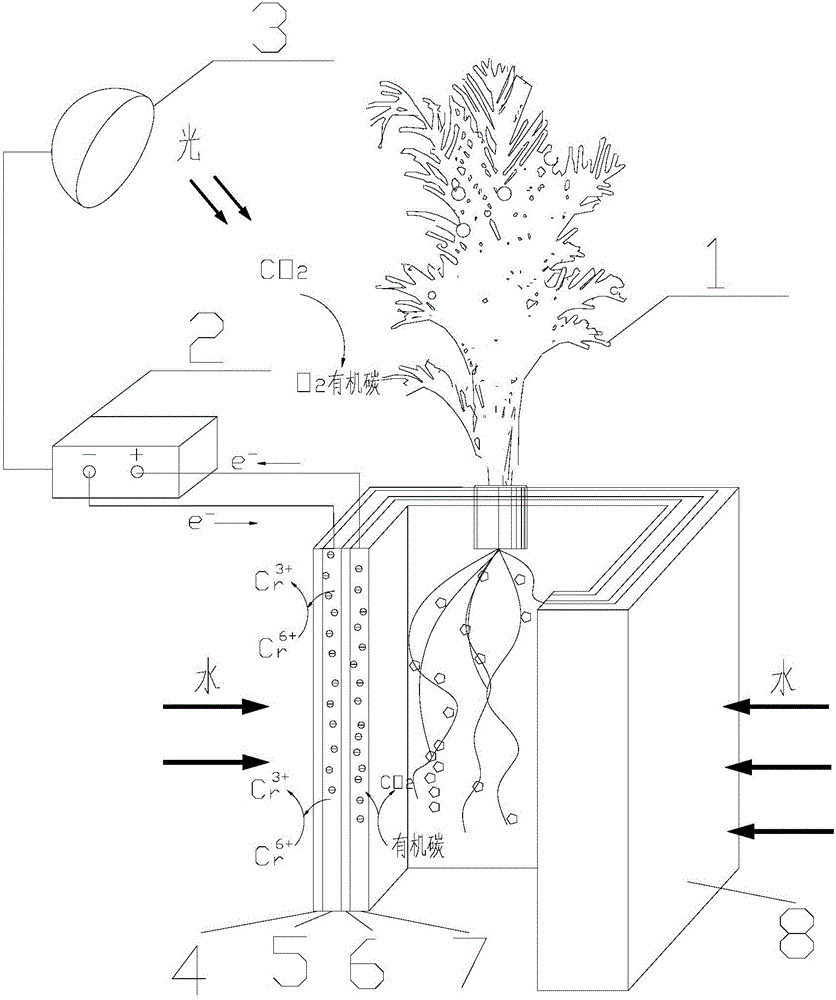Microbial fuel cell potted plant and method for in-situ remediation of soil chromium pollution
A fuel cell and in-situ remediation technology, applied in biochemical fuel cells, botanical equipment and methods, restoration of contaminated soil, etc., can solve problems such as environmental impact, cumbersome process, and multiple processing, and achieve no management and simple operation Effect
- Summary
- Abstract
- Description
- Claims
- Application Information
AI Technical Summary
Problems solved by technology
Method used
Image
Examples
Embodiment 1
[0041] Such as figure 1 As shown, a microbial fuel cell potted plant includes a flower pot 8 , a plant 1 planted in the flower pot 8 , a storage battery 2 and a light source 3 .
[0042] The basin wall structure of flower pot 8 is followed by plastic mesh film layer 4, graphite cathode layer 5, glass fiber layer 6 and graphite anode layer 7 from outside to inside; The material of plastic mesh film layer 4 plastic mesh film layer 4 is hard Polytetrafluoroethylene; the aperture of the plastic mesh film layer is 1-10mm, the graphite cathode layer 5 is detachably connected between the plastic mesh film layer 4 and the glass fiber layer 6, and the graphite cathode layer can be removed from the plastic mesh film Between layer 4 and glass fiber layer 6, graphite anode layer 7 is bonded to glass fiber layer 6.
[0043] The graphite cathode layer 5 and the graphite anode layer 7 are connected to the storage battery 2 by wires, and the storage battery 2 is connected to the light source...
Embodiment 2
[0049] The plant selected in this embodiment is sweet potato, the potted plant diameter is 50cm, and the potted plant spacing is 50cm.
[0050] In this example, the content of hexavalent chromium in the polluted soil is 800 mg / Kg, and after 70 days, the content of hexavalent chromium drops to 207 mg / kg, and the total chromium drops to 250 mg / kg, reaching the allowable standard of GB15618-1995 in my country's "Soil Environmental Quality Standards" , after 140 days, the hexavalent chromium content dropped to 45mg / kg, and the total chromium dropped to 50mg / kg.
PUM
| Property | Measurement | Unit |
|---|---|---|
| pore size | aaaaa | aaaaa |
| diameter | aaaaa | aaaaa |
Abstract
Description
Claims
Application Information
 Login to View More
Login to View More - R&D
- Intellectual Property
- Life Sciences
- Materials
- Tech Scout
- Unparalleled Data Quality
- Higher Quality Content
- 60% Fewer Hallucinations
Browse by: Latest US Patents, China's latest patents, Technical Efficacy Thesaurus, Application Domain, Technology Topic, Popular Technical Reports.
© 2025 PatSnap. All rights reserved.Legal|Privacy policy|Modern Slavery Act Transparency Statement|Sitemap|About US| Contact US: help@patsnap.com

